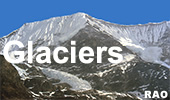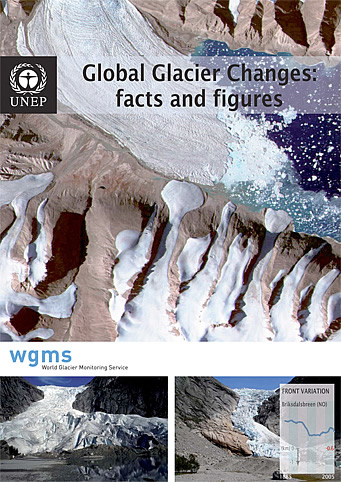| Bhutan's
glaciers and glacial lakes |
 |
Bhutan Glaciers - Glacial Lakes |
|
 |
Bhutan Glaciers - Glacial Lakes |
|
|
 |
September
2008
|
UNEP-WGMS:
Global Glacier Changes: facts and figures |

|
 |
|
Byrd-Glacier
(Antarctica) |
 |
| Monitoring
of glaciers and ice caps in Central Asia, the Tropics and in the Polar
Regions needs to be urgently stepped up, scientists and the United Nations
said.
There
is mounting evidence that climate change is triggering a shrinking and
thinning of many glaciers world-wide which may eventually put at risk water
supplies for hundreds of millions of people.
But
experts are warning that data gaps exist in some vulnerable parts of the
globe undermining the ability to provide precise early warning for countries
and populations at risk.
Peter
Gilruth, Director of the Division of Early Warning and Assessment (DEWA)
of the UN Environment Programme (UNEP) and Wilfried Haeberli, Director
of the World Glacier Monitoring Service (WGMS) urged the international
community to act.
"Excellent
data stretching back through much of the 20th century exist for large parts
of the world including Europe and North America. But the same cannot be
said for some strategically important regions of the Tropics, Central Asia
and the Polar Regions," they said. |
|
"Given
the urgency of climate change and the need for scientifically-based adaptation
strategies, it is now essential to re-initiate interrupted long-term series
in strategically important regions. It is equally urgent to strengthen
the monitoring network in those regions which at the moment have sparse
coverage and to include the latest technologies such as high-resolution
remote sensing to compliment the traditional field observations," said
Mr Gilruth and Professor Haeberli.
The
call was made during the 20th anniversary celebrations of the Intergovernmental
Panel on Climate Change (IPCC)-the scientific body established by UNEP
and the World Meteorological Organisation to advise governments on global
warming.
Here
UNEP and the WGMS released the report Global Glacier Changes: Facts and
Figures. The report presents the latest fluctuations of glaciers and ice
caps and underlines the overall trend of glaciers' retreat.
Indeed
the report confirms that the average annual melting rate of glaciers appears
to have doubled after the turn of the millennium, with record losses posted
in 2006 for a key network of reference sites.
If
the trend continues and governments fail to agree on deep and decisive
emission reductions at the crucial UN climate convention meeting in Copenhagen
in 2009, it is possible that glaciers may completely disappear from many
mountain ranges in the 21st century.
Background
Glaciers
are recognised as impressive elements of the landscape - however, in particular
they are a critical component of the earth' system and the current accelerated
melting and retreat of glaciers have severe impacts on the environment
and human well-being, including vegetation patterns, economic livelihoods,
natural hazards, and the water and energy supply.
By
looking at glaciers or what is left of them, future generations will be
able to discern clearly which climate scenario is being played out at the
present time. The consequences of ice disappearance for landscape characteristics
in high mountain areas will be felt at local to regional scales, while
the changes in the water cycle will also affect continental-scale water
supply and global-scale sea levels.
Glacier
monitoring
The
internationally coordinated collection of information about glaciers began
in 1894 and the efforts towards the compilation of a world glacier inventory
have resulted in unprecedented data sets. For the second half of the 20th
century, preliminary estimates of the global distribution of glaciers and
ice caps covering some 685 000 km2 are available, including detailed information
on about 100 000 glaciers, and digital outlines for about 62 000 glaciers.
The
database on glacier fluctuations includes 36 240 length change observations
from 1803 glaciers as far back as the late 19th century, as well as about
3 400 annual mass balance measurements from 226 glaciers covering the past
six decades.
In
2006, a new record annual mass loss was measured on the reference glaciers
under long-term observation. The average annual melting rate of mountain
glaciers appears to have doubled after the turn of the millennium, in comparison
with the already accelerated melting rates observed in the two decades
before.
The
previous record loss in the year 1998 has already been exceeded three times,
i.e., in the years 2003, 2004 and 2006, with the losses in 2004 and 2006
being almost twice as high as the previous 1998 record loss.
Early
measurements indicate strong ice losses as early as the 1940s and 1950s,
followed by a moderate ice loss between 1966 and 1985, and accelerating
ice losses until present.
The
global average annual mass loss of more than half a metre during the decade
of 1996 to 2005 represents twice the ice loss of the previous decade (1986-95)
and over four times the rate of the decade from 1976 to 1985. Prominent
periods of regional mass gains are found in the Alps in the late 1970s
and early 1980s and in coastal Scandinavia and New Zealand in the 1990s.
Glaciers
and climate
The
overall shrinking of glaciers and ice caps since their maximum extents
during the Little Ice Age is well correlated with the increase in global
mean air temperature of about 0.75 °C since the mid 19th century, which
is most likely human-induced for the most part, at least since the second
half of the 20th century (IPCC 2007). On a scale of decades, glaciers in
various regions have shown intermittent re-advances, possibly in response
to precipitation changes (IPCC 2007).
Under
current IPCC climate scenarios, the ongoing trend of worldwide and rapid,
if not accelerating, glacier shrinkage on the century time scale is most
likely to be of a non-periodic nature, and may lead to the de-glaciation
of large parts of many mountain ranges this century.
New
efforts needed
The
rapid environmental changes highlighted in the new report released today
require that the international glacier monitoring efforts make use of the
swiftly developing new technologies, such as remote sensing and geo-informatics,
and relate them to the more traditional field observations, in order to
better face the monitoring challenges of the 21st century.
|
World
Glacier Monitoring Service |
 |
The
internationally coordinated glacier monitoring was initiated in 1894, following
the example of the Swiss national observation network, and has been mainly
under Swiss leadership since then. Today, the World Glacier Monitoring
Service (WGMS) is responsible for the collection and publication of standardized
glacier data from around the world. The WGMS is located at the University
of Zurich, Switzerland, and maintains a collaborative network of national
correspondents and principal investigators in the countries involved in
glacier monitoring. The long-term measurement series of glacier mass balance
produces one of the essential variables within the international climate-related
monitoring programmes.
top
|
Links |
 |
 |
 |
External
Links |
|
Related
Information |
 |
|





